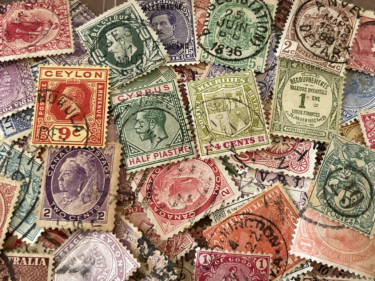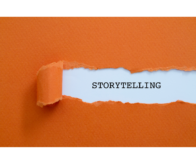Storytelling in Business Communication: The Hidden Value of a Good Story
I collect stamps. Not the most exciting of introductions to a blog, but for me the world of philately combines three of my favourite things – art, history and geography. Most of the stamps are worthless, but that’s not why I collect them. Their value lies in the story that lives within that small piece of paper. Faded postmarks tell me where and when they were used, and names of countries which no longer exist means I get some useful information for future pub quizzes (did you know Burkina Faso was once known as Upper Volta?). Holding these fragile pieces of history quickly fires the imagination. Who used them? What was happening in their life that day? What was the message they were sending?
Why am I telling you about stamps? It’s because the story that sits behind them is what makes them valuable to me. Don’t get me wrong, there are stamps in the world with a high monetary value (unfortunately I won’t be able to retire anytime soon with my collection).
A Famous Stamp Story
Perhaps the most famous and most valuable stamp is the One-Cent Magenta printed in 1856 in British Guiana. It has a captivating history and is considered the rarest stamp in the world. Originally issued due to a shortage of regular stamps, this simple stamp was intended for use on newspapers and other printed materials. Featuring a design of a sailing ship and printed in black ink on magenta paper, the stamp might not seem unusual at first glance. However, it is the only known surviving example of its kind, making it an extraordinary collector’s item. Its journey over the years includes being rediscovered by a 12-year-old Scottish boy in 1873, passing through various prestigious collections including that of John E du Pont, and breaking auction records. A lot of this is down to its scarcity, it’s the only one that exists, but the compelling backstory also adds to its value.
Significant Objects
In 2008, journalist Rob Walker and cultural critic Joshua Glenn came up with an experiment called “Significant Objects.” They wanted to see if storytelling could increase the value of everyday items. So, they visited flea markets and car boot sales and bought inexpensive knick-knacks, each costing just a few dollars. Things like random mugs, old toys, and quirky trinkets.
Here’s where it gets interesting: Instead of selling these items as they were, Walker and Glenn wrote engaging, fictional stories for each one. They gave them rich backstories that went way beyond what you’d expect from a dusty old find. Then, they listed these items on eBay, complete with their new stories, to see if the narrative would impact how much people were willing to pay.
And guess what? These ordinary items, once they had a story attached, sold for much more than their original price—sometimes over 20 times more. Take, for instance, a simple $1 wooden statue. By weaving a tale about its “ancient” origins, they managed to sell it for over $200. This experiment showed how powerful storytelling can be when it comes to changing perceptions and adding value.
Why Stories Matter
The success of this project underscores three key points about the value of storytelling:
Emotional Connection: Stories create an emotional connection between the buyer and the object. When people hear a compelling story, they can imagine themselves as part of that story, making the object more desirable.
Perceived Value: By providing context and meaning, stories can enhance the perceived value of an item. This is particularly relevant in fields like marketing, branding, and even sales.
Engagement and Memorability: A well-crafted story makes an object or brand more memorable. People are more likely to remember and value something that has a unique narrative attached to it.
Storytelling In Business Communication
In business, stories are more than just words; they’re a game-changer. They connect, engage, and inspire, turning routine exchanges into memorable experiences. Whether you’re leading a team, marketing a product, or building a brand, storytelling is a powerful tool that can help your business thrive.
The power of storytelling in business starts with emotional connections. Stories make ideas more relatable by humanising them and establishing personal ties with your audience. Customers and employees are more likely to trust and engage with a company when they hear a story that resonates. For instance, a brand that doesn’t just sell products but shares stories that speak to the heart of its customers can transform a simple transaction into an emotional journey.
Dishoom’s Story
Dishoom, the Indian restaurant chain based in London and other major cities in the UK, has masterfully used storytelling to create a unique and immersive dining experience that sets it apart from typical restaurants. By weaving narratives about Bombay’s rich cultural heritage into its brand, Dishoom has crafted a sense of nostalgia and authenticity that resonates with its customers.
Each Dishoom restaurant is designed to evoke a specific aspect of Bombay’s history. From vintage photographs and authentic artefacts to recreated colonial architecture, the décor tells a story that transports diners to another era. For example, the Dishoom branch in London’s Kings Cross is designed like a 1920s railway station café, complete with period furnishings and historical details.
The menu itself is a storytelling tool, with each dish accompanied by descriptions that provide cultural context or personal anecdotes. This approach not only educates customers about Indian cuisine but also adds a layer of meaning to each meal. On a recent visit to the Covent Garden branch, I spotted a wine called Bob, Short For Kate. As a massive Black Adder fan this grabbed my attention and led to a fascinating conversation with the waiter about the wine and its back story. The power of their storytelling means I’ll remember that meal for a very long time.
The Business Communication Takeaway
From stamps to Indian cuisine and the “Significant Objects” project, there are some valuable lessons we can embrace when it comes to storytelling in business communication:
- Building Emotional Connections: Stories forge emotional connections with your audience. In business, whether you’re marketing a product, pitching an idea, or leading a team, a compelling story can resonate more deeply than mere facts or features. For instance, when presenting a new product, sharing a story about its development journey or the problem it solves can create a stronger bond with your audience.
- Enhancing Perceived Value: Just as the stories added value to the flea market items, well-crafted narratives can enhance the perceived value of your business offerings. By framing your product or service within a meaningful context, you help your audience see it as more than just a commodity. This approach can be particularly effective in branding and differentiating your offerings in a crowded market.
- Creating Memorable Messages: Stories make complex information easier to understand and remember. Instead of boring facts and figures, a well-told story can make abstract ideas concrete, helping your audience grasp and recall key messages. People naturally remember stories, which means your message sticks with them longer. This boosts memory retention, ensuring your message stays top of mind well after the initial encounter.
- Engaging Your Audience: Effective storytelling captures and holds attention and can make your communication more engaging and impactful. But stories aren’t just about building an image; they inspire action. Whether it’s motivating employees to embrace a company vision or persuading customers to buy, storytelling frames messages in a way that resonates with the audience’s values and beliefs. This can influence decisions and spark change, turning storytelling into a powerful tool for inspiring and motivating action.
Find Your Hidden Gems
A final thought on this before I shut the laptop and sort through a battered album of mixed world stamps; it strikes me how much business communication is like philately. Each conversation, each presentation, is a stamp in your book of connections. It’s not just about selling a product or idea—it’s about creating a story that resonates, sparks imagination, and lingers in the mind. Whether you’re a business leader, a team player, or someone looking to connect more deeply with others, remember that storytelling isn’t just a tool; it’s the heart of meaningful communication. So, as I return to my stamps, hoping to find a hidden gem, I encourage you to explore the untapped potential of your own stories. You never know the value they might add to your world.


















